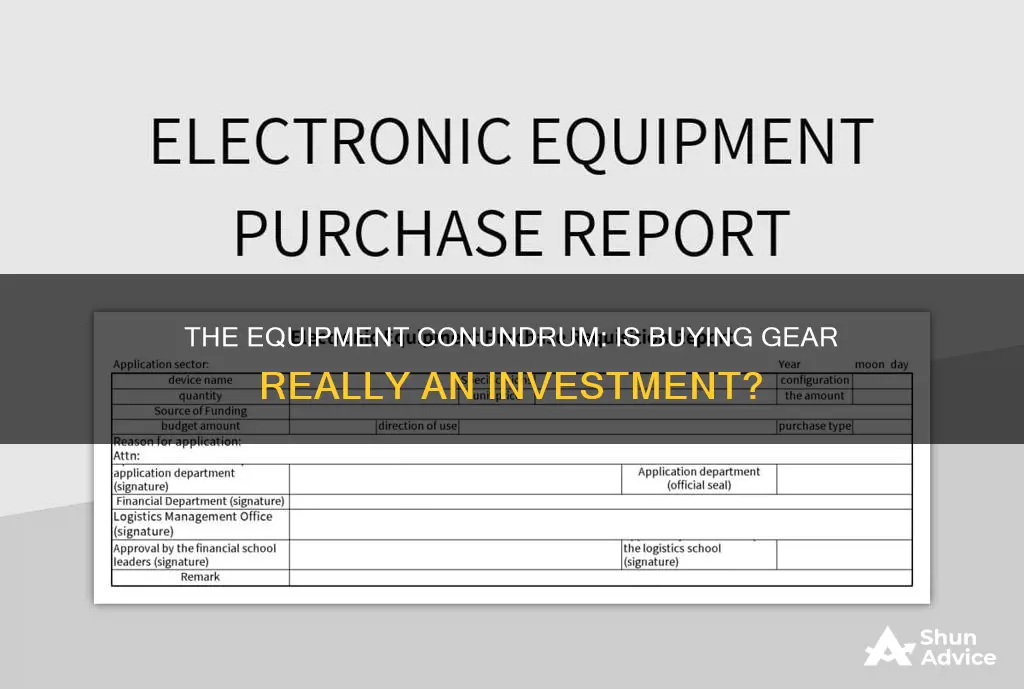
Investing in equipment can be a significant undertaking for any business, especially small businesses. It is a form of capital investment that can improve processes, productivity, capacity to innovate, and the bottom line. It is important to note that investing in equipment can be done through purchasing or leasing. Buying equipment can be a major capital expenditure, but it offers ownership and flexibility in making changes and upgrades. On the other hand, leasing equipment may be more suitable for equipment that quickly becomes obsolete or is needed for specific projects, offering lower payments but no ownership.
When considering whether to buy or lease equipment, businesses should assess their objectives, such as increasing productivity, improving their market position, and staying ahead of competitors. Additionally, creating a technology roadmap can help businesses align their equipment purchases with their short- and long-term technology solutions and business objectives.
What You'll Learn
- Investing in equipment can improve productivity, capacity to innovate, and bottom line
- Buying equipment can help businesses stay competitive
- Leasing equipment may be more suitable for equipment that quickly becomes obsolete
- Buying new equipment can improve employee satisfaction and retention
- New equipment can improve safety and security

Investing in equipment can improve productivity, capacity to innovate, and bottom line
Investing in equipment can be a significant undertaking for any business, but it can also bring about improvements in productivity, capacity to innovate, and the bottom line.
Firstly, investing in equipment can lead to increased productivity. This is because newer equipment is often more efficient and effective, allowing businesses to produce more goods or provide more services in the same amount of time. For instance, a 2017 survey of 960 Canadian manufacturers found that companies that adopted digital technologies benefited from improved productivity, lower operating costs, and better product quality.
Secondly, investing in equipment can enhance a company's capacity to innovate. By using leading-edge technologies, companies can be more agile and responsive to changing business needs and shifting consumer habits. They can also attract and retain employees by providing them with the latest tools and resources to perform their jobs effectively, improving overall job satisfaction.
Finally, investing in equipment can have a positive impact on the bottom line. While purchasing equipment requires a capital expenditure, it can lead to cost savings in the long run. For example, newer equipment may require fewer repairs and maintenance, reducing downtime and the costs associated with it. Additionally, tax incentives and deductions for equipment purchases can further improve the bottom line.
Overall, investing in equipment can be a strategic decision that helps businesses stay competitive, efficient, and profitable. However, it is important for businesses to carefully assess their needs, create an investment plan, and consider all financing options before making any equipment purchases.
College: Investing in a Brighter Future
You may want to see also

Buying equipment can help businesses stay competitive
In today's fast-paced market, any significant downtime can result in substantial revenue losses. Therefore, investing in new equipment can help businesses avoid costly repairs and unplanned downtime associated with outdated equipment. Furthermore, new equipment often incorporates more advanced security features, reducing the risk of theft, damage, security breaches, and cybercrime.
Investing in equipment can also help businesses attract and retain employees. Outdated technology can negatively impact employee productivity and job satisfaction. By providing employees with innovative tools and efficient processes, businesses can empower their workforce to be more successful in the marketplace.
When considering purchasing equipment, it is essential to assess the business's objectives and long-term and short-term needs. Creating a technology roadmap can help businesses align their equipment purchases with their overall strategy and identify investment opportunities to improve their operations and customer journey.
The Time Value of Money: Understanding Investment Growth
You may want to see also

Leasing equipment may be more suitable for equipment that quickly becomes obsolete
Leasing equipment can be a more suitable option for businesses that need to use equipment that quickly becomes obsolete. This is because leasing offers more flexibility to upgrade to newer models. When buying equipment, businesses run the risk of being stuck with outdated machinery.
Leasing equipment can be a good option for businesses that require frequent upgrades. For example, computers and other high-tech equipment can become outdated very quickly. By leasing, businesses can address the problem of obsolescence and pass the burden of outdated equipment onto the lessor. This means that the business is free to lease new, higher-end equipment after the lease expires.
On the other hand, buying equipment that becomes obsolete can be a costly mistake. If a business purchases high-tech equipment, there is a risk that it will become technologically obsolete, forcing the business to reinvest in new equipment much sooner than planned. Certain types of equipment have very little resale value, so selling outdated equipment may not be a viable option. For example, a computer system worth $5,000 today might only be worth $1,000 or less in three years.
Leasing also offers lower upfront costs and lower regular payments, which can be beneficial for businesses with limited capital or those that need to preserve cash flow. However, it is important to note that leasing can result in paying more over time than if the equipment was purchased outright.
When deciding whether to lease or buy equipment, businesses should consider their specific needs and financial situation. If a business requires frequent upgrades and has limited capital, leasing may be the best option. However, if a business is in a strong cash position and plans to use the equipment for a long time, buying may be more cost-effective.
Understanding Dividend-Paying Investments: A Guide to Profitable Opportunities
You may want to see also

Buying new equipment can improve employee satisfaction and retention
Buying new equipment can be a significant investment for companies of all sizes, but it can also bring many benefits, including improved employee satisfaction and retention. Here are some reasons why investing in new equipment can be a smart decision for businesses:
Improved Employee Satisfaction
Employees are a crucial factor in a business's success, and their job satisfaction is essential to consider. Today's employees want to feel well-equipped to perform their tasks and be efficient in their roles. Outdated or inefficient equipment can lead to frustration, decreased productivity, and even employee turnover. By investing in new equipment, businesses can provide their employees with the tools they need to succeed and show that they value their employees and their work.
Enhanced Productivity and Efficiency
New and improved equipment can help employees work more efficiently and productively. This can lead to higher output and better performance for the business. For example, investing in digital technologies can improve productivity, lower operating costs, and enhance product quality. Additionally, new equipment may incorporate innovative features, such as automation or streamlined communications, that further boost efficiency and productivity.
Increased Employee Retention
Employee retention is critical for businesses, and providing updated equipment can be a significant factor in retaining talented employees. When employees have access to modern tools and technology, they are more likely to feel valued and engaged in their work. This sense of value and engagement can lead to higher job satisfaction and a decreased desire to seek other employment opportunities. Investing in equipment can be a powerful way to signal to employees that the company is committed to their success and growth.
Better Work-Life Balance
In today's work environment, employees increasingly value their work-life balance. Investing in new equipment can contribute to this balance by reducing downtime caused by outdated or malfunctioning technology. Modern equipment is often designed with improved reliability and user-friendliness in mind, reducing the time employees spend waiting for repairs or struggling with outdated systems. This, in turn, can lead to a more positive work environment and improved employee satisfaction and retention.
Health and Safety Benefits
Employee health and safety are paramount for any business. Old or outdated equipment may pose safety risks, leading to potential injuries and increased costs associated with workers' compensation. By contrast, new equipment often incorporates advanced safety features and ergonomic designs, reducing the risk of injuries and creating a healthier and more comfortable work environment for employees.
In conclusion, buying new equipment can be a strategic decision that improves employee satisfaction and retention in several ways. By providing efficient tools, enhancing productivity, demonstrating commitment to employees' success, and promoting a healthy work-life balance, businesses can create a positive work environment that attracts and retains talented individuals.
Fees, Funds and You: The Cost of Investing
You may want to see also

New equipment can improve safety and security
Investing in new equipment can have a positive impact on safety and security in a number of ways. Firstly, it can reduce the risk of workplace injuries. Older equipment, even if well-maintained, can pose safety risks and lead to worker injuries, resulting in significant expenses from worker's compensation and other costs. New equipment is more likely to incorporate advanced safety features and technology, reducing the potential for accidents.
Secondly, new equipment can enhance security by reducing the risk of theft, damage, security breaches, and cybercrime. Outdated equipment, including computers and servers, may have weaker security controls and be more susceptible to cyber-attacks. Upgrading to newer models with improved security features helps protect sensitive data and reduce the likelihood of security incidents.
Additionally, investing in new equipment can improve productivity and efficiency, which indirectly contributes to safety and security. By adopting new technologies, companies can stay agile and responsive to changing business needs and consumer habits. This enables them to maintain their competitive edge and improve their overall standing in the market.
Furthermore, investing in new equipment can lead to improved employee satisfaction and retention. Employees who feel well-equipped and satisfied with their tools are more likely to be productive and engaged in their work. This, in turn, can enhance overall operational efficiency and security.
When considering new equipment purchases, it is essential to assess the specific needs and requirements of the business. A cost-benefit analysis can help justify the purchase and determine the potential impact on safety, security, and overall operations.
RV Reality Check: Understanding the True Costs of Ownership
You may want to see also
Frequently asked questions
Buying new equipment can improve your processes, productivity, capacity to innovate and bottom line. It can also help you stay ahead of your competitors and improve employee job satisfaction.
Buying new equipment can be expensive and may not always be necessary. It's important to assess your business reality and get an external point of view before making any purchases.
One alternative is to lease or rent equipment, especially if it is needed for a specific project or will quickly become obsolete. Another option is to upgrade your existing equipment.







